Winged Sumac, Shining Sumac, Flameleaf Sumac, Dwarf Sumac, Eastern Winged Sumac - Rhus copallinum
|
Rhus copallinum - Winged Sumac, Shining Sumac, Flameleaf Sumac, Dwarf Sumac, Eastern Winged Sumac. There are about 35 species of Rhus (Sumac) in the world, with about 15 found in North America. Two of them, Rhus aromatica and Rhus glabra, are found in each of the 48 lower states. Besides these two, the species presented here, Rhus copallinum is the most widely distributed, found in the entire eastern half of the United States, from Texas to Maine, as well as in Ontario, Canada.
There seems to be some disagreement on the division of Rhus, as it has undergone a few classification changes recently. All seem to agree with the move of Poison Oak and the Poison Ivy from Rhus into Toxicodendron. While there seems to be general acceptance that Poison Sumac (highly poisonous, but fortunately not common) should now be accepted as Toxicodendron vernix rather than Rhus vernix, many publications still list it in Rhus, and on the surface it sure looks more like Sumac than Poison Ivy to me (deeper dive may show a different story.) In the case of Winged Sumac, many authorities and publications list it as R. copallina rather than R. copallinum. Additionally, respected authorities seem to disagree on the varieties of that species. For example, Alan S. Weakley, in the November 2012 version of Flora of the Southern and Mid-Atlantic States recognizes var. latifolia, while those responsible for the Integrated Taxonomic Information System do not accept that name. Based purely on the description - with no field experience - I tend to agree with Mr. Weakley.
Found in:
AL, AR, CT, DC, DE, FL, GA, IA, IL, IN, KS, KY, LA, MA, MD, ME, MI, MO, MS, NC, NE, NH, NJ, NY, OH, OK, PA, RI, SC, TN, TX, VA, VT, WI, WV
Leave comments on Rhus copallinum at this link. | 
Distribution of Rhus copallinum in the United States and Canada:

Map courtesy of The Biota of North America Program.
Map color key
Search Our Database: Enter any portion of the Scientific, Common Name, or both.
Do a general Google search of the entire site:
#ad
 Follow USWildflowers on Twitter
#ad
| | Site: Riverwalk, Amnicola Marsh, Hamilton County, TN Date: 2013-July-27 | Photographer: Gerald C. Williamson
Nikon D7000
Tamron SP 90MM f/2.8 AF Macro | | Winged Sumac is so named because of the winged rachis (the stem to which the leaflets on the compound leaf are connected.) There are 5 to 25 leaflets on each odd-pinnate leaf; the number of leaflets is one of the diagnostics for variety the of Rhus copallinum. The leaflets are usually lanceolate, about 3 times as long as they are wide, and are typically entire, although in one of the varieties the leaflet margins may be serrate. The inflorescence is made up of a cluster of flowers with greenish-white petals; the plant is usually dioecious. | | 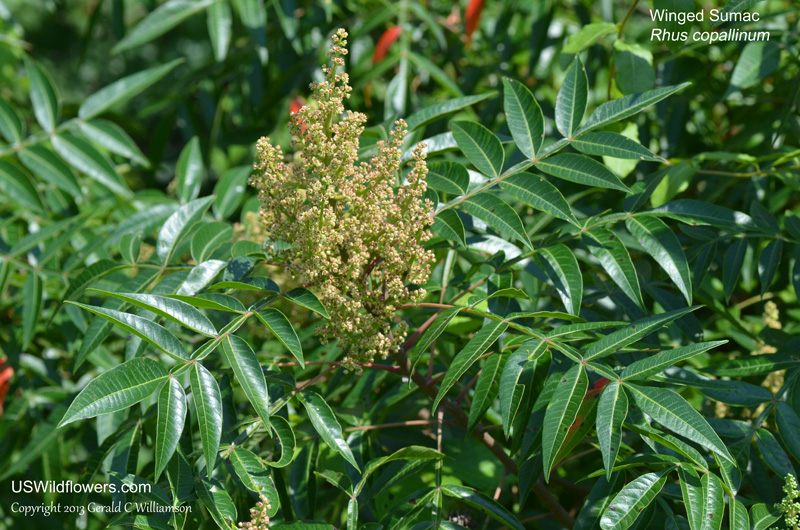
| | Site: Riverwalk, Amnicola Marsh, Hamilton County, TN Date: 2013-July-27 | Photographer: Gerald C Williamson
Nikon D7000
Tamron SP 90MM f/2.8 AF Macro | | Rhus copallinum can be a small tree up to 25 feet tall, but it more commonly appears as a shrub under 12 feet tall. | | Click on the photo for a larger image
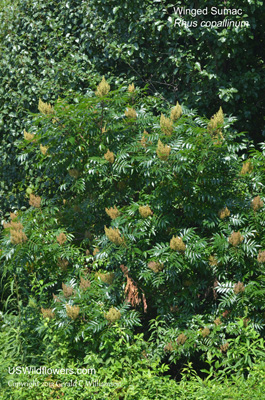
| | Site: Riverwalk, Amnicola Marsh, Hamilton County, TN Date: 2013-July-27 | Photographer: Gerald C Williamson
Nikon D7000 | | The flower of Rhus copallinum has 4 greenish-white petals. The plant is usually (but reportedly not always) dioecious - male and female flowers are on separate plants. This is apparently a pistillate (female) plant. | | Click on the photo for a larger image
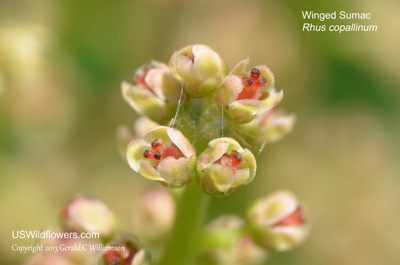
| | Site: Ascalon Road, Walker County, GA Date: 2013-August-04 | Photographer: Cindy Williamson
Nikon D60 | | The seeds of Winged Sumac are rounded and somewhat flattened. They are a conspicuous red, covered in short red hairs. In my experience the hairs are more conspicuous than those of the more common Smooth Sumac (Rhus glabra.) The seeds are also not as tightly clustered as in Smooth Sumac. | | Click on the photo for a larger image
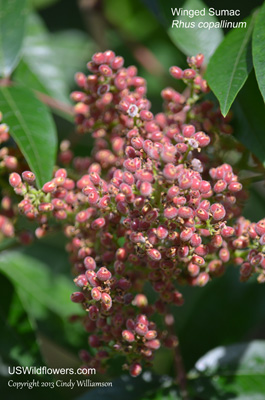
| | Site: Riverwalk, Amnicola Marsh, Hamilton County, TN and Dry Hill, Johnson County, TN Date: 2013-September-29 | Photographer: Cindy Williamson and Gerald C Williamson
Nikon D60 and Nikon D7000 | | One of the common names of Rhus copallinum is "Flaming Sumac" - so named for the fall colors, both of the leaves and of the seeds. It is one of the earliest plants to start changing to its bright red fall colors - the top photo in this pair was taken on September 29. They also participate when the rest of the trees are at peak - the bottom photo was taken on Oct 8, when the rest of the trees in the area were at peak color. | | Click on the photo for a larger image
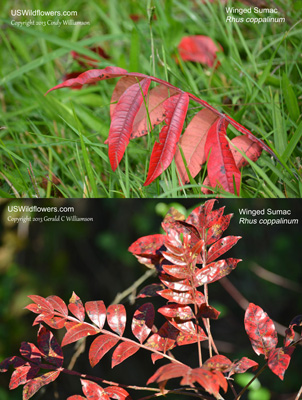
|
References used for identification and information:
|
|
| |
| #ad
|
|







